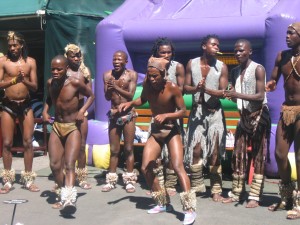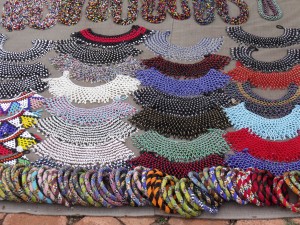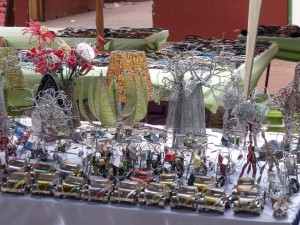This morning we are off to Rosebank Craft Market that is housed in a large mall, like many others around the world, except that it features this fabulous craft market with handmade items from across Africa, a flea market, outdoor cafes, impromptu performances and great people watching. We have come for the crafts — two floors of jam-packed little stands with eager sellers. I decide to survey the entire market before purchasing anything — always a good idea! I also want to survey the pricing as I have no idea what one should pay for things here. There is much to see but many vendors carry identical wares. I search for what is unique. Textiles are my weakness and several stands carry raffia mats from the Congo that are beautifully woven in earth colors with erratic geometric patterns. In the flea market section I come upon a vendor who has everything spread out so I can look through the piles without assistance. There are way too many and it all becomes a blur but finally I settle on two small ones for which I pay 350 rand or about $50.
The beadwork is amazing. Every imaginable type of jewelry and toys are made with beads and wire. Apparently this technique originated in the Congo and Malawi. I buy two funny little critters and a gorgeous necklace. Thankfully the vendors are not very pushy. It is customary to bargain a bit but I’m not fond of the process.
After a while we select a deep corner of the Europa Café for our meal of the day. How civilized this all feels. Good food and time to enjoy it. Afterward we come upon some street performers – two young men who are doing a variation on vogueing with their double-jointed shoulders. Their movements make us wince. Next are some fire-eaters who do nutty things like lighting a pot on fire and wearing it as a hat. Ouch! The best of all are a group of traditional singers and dancers dressed in animal skins.
From the market we head back to the next performance by a young hip hop company, Konexion. Nine dancers organized into three groups perform an hour-long series of loosely choreographed sections demonstrating a variety of styles. The breakers are pretty hot and show off some inventive variations on familiar moves. There physical feats seem anatomically impossible. One little guy has the arms of King Kong and does amazing stuff on his hands. Overall it’s more of a review than a dance but fun to see.
Then we wander back over to the Dance Factory for a performance/installation, “The Time of Small Berries” created/performed by Sello Pesa and erf [81] cultural collective (Peter Van Heerden and Andre Laubscherz). We enter the theatre and are led not to the seats but instead back out into a rear courtyard where a mutton is roasting on a spit. Sello is in a corner performing a ritual bathing from a bucket of water. He does a thorough job including teeth brushing. Then a large, noisy garage door is hand cranked open to reveal a scene (on the stage) of a table set for dinner for 10 or so — white linen, crystal glasses…the works. Chairs are set up surrounding the table for viewers. Andre invites members of the audience to take a seat at the dinner table. He commences to engage the guests and members of the audience in a discussion of culture, rape, race, politics and privilege. Some ‘diners’ appear to be planted at the table to spur the dialogue. A series of wild actions ensue around the table. Sello ties Peter up with a garden hose. A bag of corn hung from the ceiling is smashed and pours onto the floor. We hear chickens clucking away in the corner. The rooster eventually ends up under my chair. The garage door creaks opens again and Andre goes out with an electric carver to slice off some mutton to serve the guests. Three crates of beer are brought in and passed around. Several bottles are ritually sprayed around the space and over the pile of corn. Various people rant on about politics. Sello changes his clothes mounts a pile of crates and begins giving a presidential speech. He changes his clothes and characters and repeats this several times. Peter attempts a nearly impossible task of carrying two broken bags of corn around the room. A futile effort — the corn spills out everywhere. Sello pees in a pail and I cannot watch what he does with it. This type of performance art is not my cup of tee.
Eventually the scene dissolves and the crowds wander out around the roasting lamb to eat, drink beer, socialize and discuss the piece.What seems evident is that “The Time of Small Berries” is speaking to what happened to the traditions of the indigenous people under colonialism.
In the talk the previous day Peter van Heerden (a member of erf) talked about “the body as live art inscribed by life’s experiences.” Their interest in this work is to explore what it means to be African in this moment in South Africa and how to assimilate and move forward.
This is the big question on everyone’s mind — how to move forward. In one way or another nearly everyone is grappling with this issue. Seventeen years into a young democracy with the weight of such a tragic and difficult history South Africans of all backgrounds are seeking a way forward to peace, equality and prosperity for all. Many inequities remain in play. Our visit to Soweto (coming up) helps us Americans to fill out the picture.




